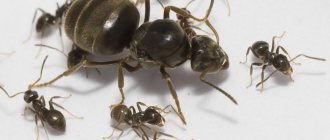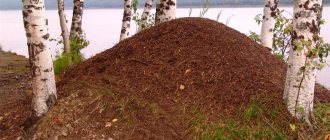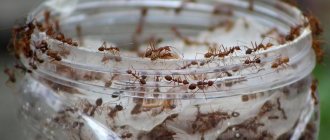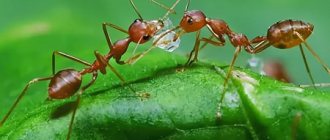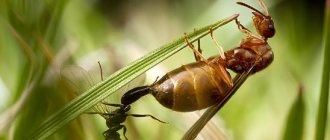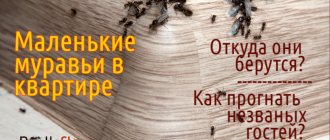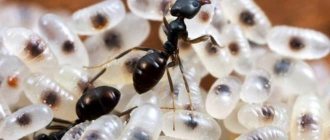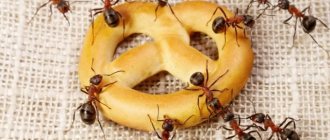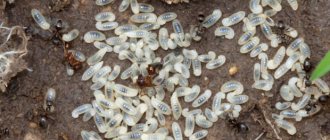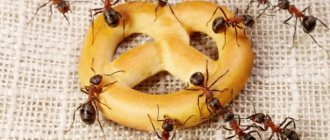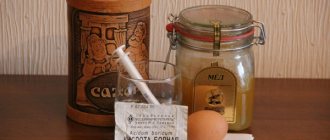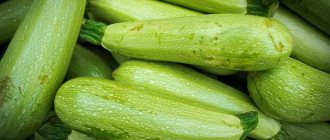What do ants need for normal life in a formicarium? Preparing a complete and varied diet for ants. Examples of foods containing proteins and carbohydrates. How much food is needed for arthropods? Useful microelements. Growing food insects.
The key to a thriving colony is the availability of a nutritious and varied diet. Speaking of natural conditions, ants feed on different types of insects - flying, crawling, living and not, a variety of plants, and aphids share the sugar they extract with arthropods.
Providing adequate nutrition for a home colony is not an easy task; let’s look at what to feed the ants in an ant farm. Conventionally, the diet of such insects is divided into carbohydrate and protein food. Equally important is compliance with the intake of salt and microelements.
Protein food
All ants are predators by nature. Even if we are talking about a non-aggressive species of ants. They happily drag a found caterpillar or beetle into their anthill. This means that you must feed the ants living in the ant farm with protein. Dried gammarus, lean meat, shrimp, boiled egg, fish, nuts. It is better to scald raw foods, such as meat, with boiling water before serving.
The favorite foods of ants are zoophobes, medicine man, crickets, mealworms and other feeding insects. Remember that these treats must be purchased at a pet store or grown yourself. By bringing beetles from the street, you risk infecting the colony with parasites.
Important! If the ant family is still small, then live food should be given with caution. It must be killed before being placed in the feeder. Otherwise, the insect may harm the colony or even lead to its death.
The development of the colony directly depends on the amount of protein eaten. Protein is especially useful for the queen. Don't forget to regularly pamper the colony with meat and live food. In gratitude, you will receive a huge clutch of eggs from which large soldiers and workers will be born. But if the queen understands that she has nowhere to get the squirrel, then she will eat the brood.
Proteins fats carbohydrates
It is into such groups that most food products, not only of the human, but of the ant world, can be divided. What is worth remembering right away: under no circumstances should you give any fats or carbohydrates in their pure form to ants - they are guaranteed to lead to the death of the insects.
We have collected the types of food that can be given to reapers in a table:
| Protein food | Fruits |
| Boiled egg | Apple |
| Boiled fish | Pear |
| Boiled chicken | Banana |
| Gammarus | Grapes (with caution) |
| Feeding insects | A pineapple |
Strictly prohibited:
spicy, fatty, syrups.
The type of insect certainly influences the formation of the diet. Messor structor, as befits reapers, love grains and seeds. But they can eat a boiled egg if they are in the mood, although standard food is more than enough for them.
Any syrups and sweets are strictly prohibited. You can diversify the diet with food for canaries or gammarus (dried crustaceans for aquarium fish), these are proven options.
Important:
All types of ants need crushed insects to maintain vitality. When giving insects, make sure that they cannot harm the colony and are proportionate to the number of eaters.
Please note: you cannot bring indoor or outdoor insects into the arena; they can become a source of infections, contain insect poison in doses sufficient to kill the colony, as well as micromites that can destroy the anthill. It is better to purchase insects in special stores.
Messor structor syrup should absolutely not be given; they get the carbohydrates they need for life from grains.
Watch the video of harvester ants feeding, as well as their reaction to ice and artificial snow in the arena:
Hard food
The Reaper Ant (Messor Structor) is a granivorous ant - gatherer. Speaking about grain feed, we will talk about this type. A mixture of seeds and various grains is a source of energy for little hard workers. Ants living at home should have constant access to carbohydrates. You can place a feeder filled with seeds in the arena. They will definitely carry some of the grains into the living passages of the formicarium. Having chosen the driest chamber, they will arrange a storage room there. This will be an emergency reserve. They will take care of it, sort it out and dry it.
The grains left in the arena will be the main food. Soldier ants with large mandibles grind seeds into flour for the whole family.
Poppy seeds, rapeseed, millet, sesame, flax, millet, alfalfa, chia are best suited. Wheat, oats, pumpkin seeds, etc. will be too large for them.
One species - one diet
There are over 14,000 ants living in the wild. Each species developed in certain conditions and is evolutionarily prepared for certain food. If you give other food, the colony may die. In the Species section you will find articles with ant cards, after reading this article I recommend that you read about a specific species.
Ants can be divided into carnivores and vegetarians. For example, cleaner ants should be fed grains indoors to form, which is the basis of their diet in the wild. Garden ants, on the other hand, are better at feeding on sugar syrup and insects.
Queen of black garden ants
However, the colony needs fats, proteins and carbohydrates. The biochemistry of living beings is the same. Any food contains proteins, fats and carbohydrates, but in different proportions. The structure of substances is also not the same, as is their origin.
Plant and animal proteins differ in structure, in the combination of amino acids and in the connections between them. The enzymes of each ant species are adapted to a specific combination of amino acids and the bonds between them. Therefore, it is better to feed ants at home with what this species is evolutionarily adapted to.
Just think of something else =)
Syrups and sweet fruits
Ants have a real sweet tooth. In nature, they feast on flower nectar, carbohydrate-containing plant sap, and aphids. The latter is like a cow to them. Only what they get from it is not milk, but a sweet solution (honeydew).
In a formicarium, the ant economy, of course, will not be able to develop like this. Therefore, it is the owners’ task to deliver treats. You can use sugar or honey syrups, or glucose purchased at the pharmacy.
Important! It is strictly forbidden to give sweets to the Reapers. Sweet fruits and syrups lead to dehydration and death. In just a few hours, the entire colony can die.
Remember that syrups are a perishable product. Do not allow it to sour inside the farm.
Portion or quantity of feed
Many novice myrmikeepers have a fair question - how often to feed the ants? Lunch time, as well as portion size, matters. Loving owners often show unnecessary care and overfeed their colony. This can be even more harmful than short hunger strikes.
Careful observation will help you determine how much to eat. If pets leave an uneaten piece of boiled meat or half a cricket, it means they are full. The remains should be removed from the formicarium, and next time a smaller portion should be offered.
If you notice that newborn babies are small in size, this indicates a lack of food. Add protein dishes to your diet. It is the protein that helps the brood mature and grow into normal-sized individuals.
Over time, each aspiring myrmikeeper gets to know his colony better. There is an understanding of portion size and culinary preferences. Watch your pets, notice changes in mood and activity. Feed a variety of healthy foods. Do it carefully and with pleasure.
How to properly moisturize a formicarium
Each formicarium initially has chambers for moistening the formicarium. The frequency of filling the chambers with water depends on the type of ants in your formicarium. Be careful when moistening the ant farm, these insects are terrestrial animals and if the humidity is too high, they will die. It would be correct to fill the chamber that is located further from the ants with water. If necessary, the ants themselves will move closer to optimal conditions. The absence of condensation and water film may be a signal for the next addition of water.
How to get and where to get ants for a formicarium?
Reaper ants or steppe ants are one of the easiest species to keep for beginners. At the head of such a colony is a queen, which lays eggs and contributes to the growth of the family.
How to get and where to get ants for a formicarium:
- Buy a small colony, which is sold in small tubes. Typically this is a queen along with 10, 20 or 30 workers.
- If you are not ready to spend money on purchasing a colony, you can do the following. In nature, females and males mate in spring. These ants, unlike the usual ones, have wings. Later, after fertilization, the queen gnaws off her wings, descends underground, or climbs under a stone or dry tree. There the process of digging holes and laying eggs begins. During the mating period, it is necessary to get out into the steppe and look for similar insects with wings. Fertilization of the uterus occurs only once in a lifetime; it works with the accumulated sperm capacity, laying eggs. Some time after fertilization, the males die. Next, the queen begins laying eggs.
- As soon as you have a queen, you need to transplant it into a test tube with moistened cotton wool, and place there a small piece of walnut, the size of a match head, and a few dead mosquitoes. This is because ants in nature also eat dead insects to provide themselves with protein.
The most remarkable thing is that the whole family consists of females, males, and workers. Workers are females, but with underdeveloped reproductive organs that cannot produce offspring. They are the ones who do the cleaning, some are nannies, and feed the offspring. In such a family there are individuals who carry out cleaning, carry dead insects and debris to a designated place so as not to clog the formicarium or nest. It is worth noting that entomologists consider ants to be the most developed of all insects. It is believed that an anthill is a single whole organism, each of which has its own purpose and purpose. The work is distributed, everyone knows what to do. The queen lays eggs, other insects feed them, another caste cleans and protects the anthill from attack by other insects.
Murashka
Nutritional Features
The feeding habits of reapers have created several transitional forms among worker ants.
It takes a lot of effort to grind cereal grains. Thus, the large head of soldier ants is the result of the development of massive occipital muscles, which are responsible for the work of the lower jaw. The prepared seed pieces are processed by smaller worker ants, as it requires less effort. Next, the grains turn into flour and are moistened with saliva. This gruel is fed to the larvae. In addition, ants also eat animal food: they collect dead insects or organize collective hunts themselves. However, this type of food is secondary.
Drinking bowl for harvester ants: whim or necessity?
One of the hot topics in discussions on the keeper forums is whether the reapers need a water bowl in the formicarium, or whether they can do without it. The truth is that in nature, no one gives water to reapers. Conditions in the natural habitats of this species are characterized by high humidity and elevated temperatures. Due to this circumstance, messor structors are accustomed to taking water from the air. Ideally, this should also be the case when kept at home.
To bet or not to bet
There are actually situations in which reapers will need liquid, but they all involve lowering the humidity on the farm. If for some reason the humidity drops below 70%, and there is no way to influence this, installing a container with water will be the only possible solution.
A drinking bowl will also be needed in cases where the farm owner leaves for longer than 4-5 days and there is no one to water the farm.
You can make a drinking bowl yourself or purchase a ready-made version, tailored to the size and conditions of your formicarium:
Moistened piece of cotton wool
- the simplest option, requiring frequent replacement.
Any hollow tube, test tube, cap
, into which water is poured and then tucked with a cotton swab - lasts much longer.
The finished drinker has an internal dosed feeding system; it is good because it does not require unnecessary movements from the keeper: fill it up, set it up and forget it. Which option you choose doesn’t really matter. After all, they will all solve the task, namely, provide the ants with water. However, it is worth taking care to return the reapers to their natural level of humidity as soon as possible, because they are accustomed to absorbing water from the air; a separate supply of water for them is rather a temporary, necessary measure.
See what's included in each kit:
Source
Appearance of harvester ants and their habitat
The body of insects consists of three parts - the head, thorax and abdomen. They are connected to each other by movable jumpers, which makes the reapers very flexible. There are three pairs of limbs on the chest. The large head has powerful jaws - mandibles, which are convenient for carrying food and grinding seeds and grains. The color of the ants is dark, reddish-brown. Their length is considered one of the largest among other families of ants: worker ants have a length of 4 to 9 mm, while the queen reaches truly enormous sizes - from 11 to 15 mm.
Harvester ants live in steppes, semi-deserts and deserts in Asia, North and South Africa and America.
What to feed ants in an ant farm
They easily find all these useful products during their lives and are saturated with them. By looking at and studying the diet of wild Hymenoptera insects, you can understand what ants that live at home need to live a full life. Like humans, they have the basis of good nutrition - proteins, carbohydrates and microelements. All this is necessary for the passage of vital processes in the body of a living being. The size of food consumed is also important. It can also be noted that different types have their own taste preferences, so-called national dishes. What to feed ants in an ant farm? Squirrels
As we all know, ants are capable of lifting and carrying objects that are several times their own weight. Therefore, protein occupies the main place in their diet. It is necessary for further cell growth and repair. Proteins also contain essential amino acids and microelements.
Insects used for food are the best source of protein of all possible feeding options for ants. Wild ants prefer crickets, cockroaches and other insects. Before you buy and offer various ants, you need to make sure that they are not poisonous and will not harm your pet in any way. Myrmikeepers or ant keepers give their preference to boiled chicken meat. A fairly reasonable choice: to feed the family and to share with the ant colony. It is necessary to take into account that domestic creatures do not like various kinds of additives and seasonings.
It is not recommended to use fatty foods. For example, pork, beef and any other meat. Ants give their choice to low-calorie meat. You don’t have to think about how to prepare food for your little friends. Simply boil the chicken. The dish is ready. Ants also love boiled eggs. However, they only need low-calorie protein. For an entire colony, only a small piece of dietary product is needed. It would be enough.
The favorite delicacy of little athletes is shrimp.
However, you should not allow them to be enjoyed too often. Shrimp contain a huge amount of vitamins and minerals, but they should be served on exceptional days. They are also easy to prepare: boil or steam. Just one shrimp is enough for an entire farm. The most important thing is still the quality of the products. It is necessary to feed insects only with proven products. Also remember to clean up leftover feed to keep the farm clean. And remember, proteins are an essential part of the diet. Now we have dealt with the question of what to feed the ants in an ant farm. Carbohydrates
Ants are constantly at work. They can be called small perpetual motion machines. Their activity and cheerfulness is determined by the carbohydrate content in their diet. Wild insects get them from plants: seeds, juice, pollen. Accordingly, this is what pets should eat. There is a division of ants into two groups:
- granivores;
- sweet tooth.
The diet of the former consists of consuming seeds and grains.
Millet fodder grass, the national dish of the reapers. Macro is a genus of herbaceous plants, also a useful product for ants. There is an assumption that thanks to poppy, ants rest and relax after a hard day. Mustard seeds are an excellent natural remedy for health as they have antimicrobial properties. Rapeseed is a type of herbaceous plant of the Cabbage genus. The grains of this plant are excellent for ants. Amaranth is a tropical plant, a source of strength for ants. Exactly what they need. Potatoes are a favorite delicacy of ants. Potatoes contain a wide variety of useful substances, so they are very necessary in the diet of not only people, but also insects. It should be served only boiled without various additives. For one hundred ants, it is enough to cook 1 potato every 2 weeks.
The most important thing is variety.
After all, ants are also living beings, they also undergo metabolic processes. Sweet syrup - plant juice, nectar of flowers. For domestic ants - water with sugar or honey. Preparation of syrup: mix 1 part sugar (honey) with 4 parts water. It is best to pour the solution onto a cotton pad and put it in a sippy cup, then the goosebumps will not drown in sugar happiness. It is necessary to monitor the cotton pad so that it does not turn into a lump of sugar, so you should give a minimum amount (at a time). Fruits are an excellent substitute for a sweet solution, as they contain fructose. Ants love both apples and grapes, it all depends on personal preference. However, you need to be extremely careful. The fruit can be given to colonies containing more than 500 individuals. Otherwise, the farm may be poisoned.
Feed size
Before feeding ants in an ant farm, you need to understand a certain norm. People who run a farm are well aware of the need to respect feeding times and meal sizes. Overfeeding can cause more harm to ants than underfeeding. It's important to keep an eye on this.
Only looking after the animals will help you understand how much your colony needs. If pets are malnourished, then the leftovers must be removed and in the future given less food. If the babies born are very small, this indicates that they do not have enough food. In this case, it is necessary to increase your protein intake. It will help little residents grow up. The most important thing is to love your job and treat your farm responsibly.
How ants feed the queen
First, the queen is large and self-sufficient enough to take care of herself. In the end, she somehow survives on her own. She lives off her own fat deposits and decaying muscles.
The ants try to provide the queen with protein and carbohydrates. Protein is preferable. Therefore, the queen lays more eggs.
An ant has two stomachs. One for yourself. The other stomach is used to store food. This is known as tropholaxis. One ant approaches another. He knocks on the antennae and receives food in return.
Reaper's womb
The same scheme works for the uterus.
How is an anthill organized?
In a colony of harvester ants there is a strict hierarchy: each family member is busy with his own business. The family consists of a queen - she produces offspring, soldiers - they protect the anthill from dangers and help with harvesting, worker ants - they are engaged in obtaining food and caring for the young. There are also males and females - they mate with each other, creating new colonies.
The ground part of the ants' home is a hole in the soil, along the edges of which there is a shaft of earth and debris from the prey they bring. The underground part has a vertical tunnel, from which passages with cameras extend on the sides. In these rooms, ants set up pantries for storing food and “children’s rooms” in which they store larvae.
Reaper ants: reproduction
Ant reproduction begins in April, when the queen returns from her flight, chews off her wings, and climbs into the hole. Before the onset of summer heat, there are already several worker insects that can be engaged in foraging.
Reaper ants, reproduction:
- At the initial stage, the queen lays eggs, which then turn into larvae and pupae. The pupa does not have a dense shell, so its development can be observed. As mentioned above, the harvester ants have a division into castes and each one does his own thing. The larvae cannot move independently, so they are fed by nurses, nannies or wet nurses. Reaper ants mainly feed on grains that are ground into flour by soldiers. They differ from other inhabitants of the farm in their larger size and massive head.
- This is due to the fact that they have very large jaws that are capable of grinding grains into small pieces. The crushed grains are handed over to ordinary workers, who then grind the pieces into flour. The nurse mixes flour with saliva and feeds the larvae. It is worth noting that an ordinary working female is also capable of laying eggs, but they will also be workers. In order for an egg to become a female or a male, it must be laid by the queen. Only she has a supply of sperm inside her abdomen, which is capable of producing full-fledged, sexually mature individuals.
Ants
How to keep harvester ants at home
Nowadays, many people, as a hobby, start so-called ant farms, which are transparent boxes made of plastic or glass. Inside them there is an imitation of an anthill - numerous passages and chambers.
Purchasing an anthill - what kinds of anthills there are, their cost
A home anthill, or formicarium, looks like an aquarium or a display case with filler inside. There are simple and complex systems in which a climate favorable for the life and reproduction of ants is automatically created and maintained: lighting, humidity and temperature. There are different sizes - from small tabletop farms to bulky anthills for the living room or office. Various fillers are used for formicaria: gel, gypsum or a mixture of soil and sand.
The so-called “Cubus” and “Colosseum” models are shaped like a cylinder, cube or double-walled display. The space between them is filled with multi-colored sand, in which the ant colony builds passages and chambers. The cost of such structures is high - from 3 thousand rubles, but the kits include food for ants, sand and other additions.
An anthill with a gel filler is similar to an aquarium, but is filled not with water, but with a transparent gel. Such a house for reapers does not require careful maintenance, but once every 5–7 days the lid of the aquarium must be opened for a couple of minutes for ventilation. The price of such formicariums is low - from 500 rubles.
A plaster truss is affordable in price (from 700 rubles). This is the most popular type of domestic anthill. The surface of the gypsum is often painted in bright colors, which makes formicariums a stylish and unusual addition to any interior.
Ant houses can be purchased in specialized online stores. The catalogs contain farms of various models and sizes. As a rule, pet stores do not sell ant farms.
Making a formicarium yourself
If you are not attracted by prices in stores, then there is the opportunity to make a formicarium with your own hands. For the base, you can take two jars with transparent walls - a large and a small one - and then fill the space between them with the selected material. It can be a mixture of soil and sand, gypsum or gel.
Soil-sand farm
To begin, prepare a mixture of one part sand and two parts soil. Make sure that the composition is slightly damp - it will be easier for ants to break through passages and chambers. The mixture will be needed so much that the space between the jars is filled 1.5 cm from the edge of the vessels. Make small holes in the lid for air circulation.
Gel farm
Making such a farm yourself will be interesting for both adults and children. To do this, you will need gelatin and a flat container with a lid and transparent walls.
Pour three 15 gram bags of gelatin into 0.5 liters of hot water and stir well until the gelatin dissolves. Then add another 0.5 liters of water. Cool the resulting composition, pour into a container of your choice and place in the refrigerator until completely solidified. Then remove the container and wait for the mass to warm to room temperature. Since the gel composition is also food, there is no need to feed the ants in such an anthill - they will get the necessary food from their house.
Gypsum farm
To create an anthill, take a transparent container, then dilute the plaster to a thick sour cream. Pour the composition into a transparent plastic container, placing a plastic straw at the side. This is necessary in order to then add water to the plaster to maintain humidity in the formicarium.
The workpiece dries completely in about a week. After three to four days after pouring, remove it from the mold. To make the plaster come out easily, immerse it in hot (not boiling water) water for thirty seconds.
Now show your creativity - draw passages and rooms on the plaster. The composition is still raw, so it will not be difficult for you to scratch out any tunnels.
Drill an entrance for future residents of the farm using a drill. Take any tool convenient for you (a stationery knife, screwdriver, etc.) and start making paths according to your design, choosing plaster from them. Proceed with caution so that the wet mixture does not crumble.
Make indentations at the bottom of the formicarium to better distribute water and moisturize the anthill. Don't forget about the ventilation holes in the container. Drill them with a drill (0.5 mm diameter) in the lid and side walls.
After this, you need to thoroughly dry the gypsum base and place it back into the container. If it does not fit, soak the mold in hot water again for 30 seconds. Your anthill is ready to move in.
How often to feed ants
There are 2 main problems when feeding ants. Overfeeding and underfeeding. If you don't feed them, they will starve. Then, when food becomes available, they will spend it more sparingly. Stock up in case of famine.
If the ants do not get enough food, the size of the young decreases. Less food, less protein, less energy. In this case, it is more advantageous to be a small organism.
If there is too much food, the ants may not get enough food, which means an increased risk of mold and mites. These are harmful neighbors for ants. If the food is dusty and the ants do not touch it, it means there is too much of it. It's more likely that it's in a cell where it can't be reached.
We came to the conclusion that it is better to give food in small portions, which the ants quickly digest. Then we reduce the risk of mold to zero. And the ants will be pleased with their large size.
Harvesting machines place their supply of seeds into the chamber
